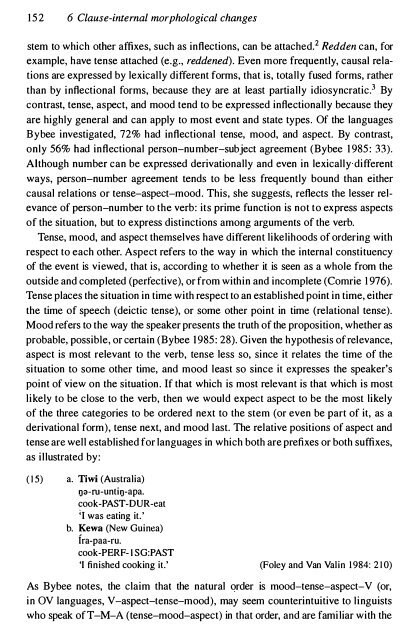Gram - SEAS
Gram - SEAS
Gram - SEAS
You also want an ePaper? Increase the reach of your titles
YUMPU automatically turns print PDFs into web optimized ePapers that Google loves.
152 6 Clause-internal morphological changes<br />
stem to which other affixes, such as inflections, can be attached. 2 Redden can, for<br />
example, have tense attached (e.g., reddened). Even more frequently, causal relations<br />
are expressed by lexically different forms, that is, totally fused forms, rather<br />
than by inflectional forms, because they are at least partially idiosyncratic. 3 By<br />
contrast, tense, aspect, and mood tend to be expressed inflectionally because they<br />
are highly general and can apply to most event and state types. Of the languages<br />
Bybee investigated, 72% had inflectional tense, mood, and aspect. By contrast,<br />
only 56% had inflectional person-number-subject agreement (Bybee 1985: 33).<br />
Although number can be expressed derivationally and even in lexically different<br />
ways, person-number agreement tends to be less frequently bound than either<br />
causal relations or tense-aspect-mood. This, she suggests, reflects the lesser relevance<br />
of person-number to the verb: its prime function is not to express aspects<br />
of the situation, but to express distinctions among arguments of the verb.<br />
Tense, mood, and aspect themselves have ditl'erent likelihoods of ordering with<br />
respect to each other. Aspect refers to the way in which the internal constituency<br />
of the event is viewed, that is, according to whether it is seen as a whole from the<br />
outside and completed (perfective), or from within and incomplete (Comrie 1976).<br />
Tense places the situation in time with respect to an established point in time, either<br />
the time of speech (deictic tense), or some other point in time (relational tense).<br />
Mood refers to the way the speaker presents the truth of the proposition, whether as<br />
probable, possible, or certain (Bybee 1985: 28). Given the hypothesis of relevance,<br />
aspect is most relevant to the verb, tense less so, since it relates the time of the<br />
situation to some other time, and mood least so since it expresses the speaker's<br />
point of view on the situation. If that which is most relevant is that which is most<br />
likely to be close to the verb, then we would expect aspect to be the most likely<br />
of the three categories to be ordered next to the stem (or even be part of it, as a<br />
derivational form), tense next, and mood last. The relative positions of aspect and<br />
tense are well established for languages in which both are prefixes or both suffixes,<br />
as illustrated by:<br />
(15) a. Tiwi (Australia)<br />
O:l-ru-untio-apa.<br />
cook-PAST-DUR-eat<br />
iT was eating it.'<br />
b. Kewa (New Guinea)<br />
fra-paa-ru.<br />
cook-PERF- I SG:PAST<br />
'I finished cooking it.' (Foley and Van Valin 1984: 210)<br />
As Bybee notes, the claim that the natural order is mood-tense-aspect-V (or,<br />
in OV languages, V-aspect-tense-mood), may seem counterintuitive to linguists<br />
who speak ofT-M-A (tense-mood-aspect) in that order, and are familiar with the
















